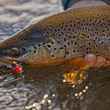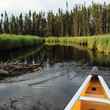Curling, for those of you unfamiliar with it, is an arcane winter sport of Scottish origin in which one player slides a 42-pound disc of polished granite down a sheet of ice toward a kind of bullseye target. This disc, called a “stone,” moves at a glacially slow rate of speed, and as it’s doing so the other players furiously sweep the ice ahead of it with brooms in order to influence its velocity and direction of travel.
This curious spectacle inspired Frank Deford, the legendary Sports Illustrated writer, to tartly observe “Curling is surely the one sport in all the world in which the players themselves move faster than the object they put into play.”
John Rucker can relate to that. A 74-year-old retired English teacher who lives off-the-grid in eastern Montana, in the fall he and his pack of homebred Boykin spaniels hunt regulation, which is to say fast-moving, game: pheasants, Huns, sharptails. But for three-to-four months every spring and summer, Rucker and his dogs head east to hunt—wait for it—turtles.
Land-dwelling box turtles, to be more specific, which are increasingly threatened, in many areas, by disease and/or habitat loss. Various entities with a vested interest in turtle conservation, including universities and state departments of natural resources, employ the Rucker “team” to help them get a handle on numbers, distribution, age demographics, and the incidence of disease in the turtle populations under their purview. Depending on the location, these can be Eastern box turtles, Ornate box turtles, or Three-toed box turtles.
Regardless of the species or the location, though, they’re still turtles. On a good day, they can do the quarter-mile in an hour. The point being that if they’re not the slowest things ever hunted with dogs, I don’t know what is. On second thought, let’s make that the slowest living things, just to eliminate antler sheds from contention. Hence the relevance, thin though it may be, of the Deford observation.
Spectators often show up to watch the turtle-hunting show and, in Rucker’s telling, “They absolutely freak out when they see these high-powered dogs hunting turtles at the same speed they hunt rooster pheasants. They expect to see them tip-toeing along not much faster than the turtles, I guess.”
More Like This
The Boykins respond the same way to turtle scent as they do to pheasant scent. “It’s exactly the same as when they get birdy on a rooster,” Rucker says, noting that he leaves the tails of his Boykins undocked in order to see them better in the knee- to waist-high grass they’re typically hunting in.
“I’m viewed as a renegade by the Boykin spaniel ‘establishment,’” he laughs, “because I don’t dock the tails. That’s heresy to those South Carolina bluebloods.” (FYI, the Boykin spaniel is the state dog of South Carolina.)
And what do the Boykins do when they find a turtle? They promptly scoop it up and retrieve it to Rucker, of course. He, in turn, hands it over to a technician, trained in reptile biology, who takes blood and saliva samples (to test for disease), checks for parasites, and in some cases may affix a tiny radio transmitter so that its movements can be tracked. The turtle, unharmed and by all appearances unfazed, is then released back into the wild.
If you’ve ever wondered how catch-and-release hunting would work, that’s a pretty good template. In 2022 Rucker and his dogs hunted in five states—Wisconsin, Michigan, Iowa, Illinois, and Tennessee—and tallied well over 500 turtles. Most box turtles are six-to-eight inches long and weigh about a pound, according to Rucker, although his dogs have found Eastern box turtles in Michigan weighing twice that much.

Wildlife veterinarian Dr. Matt Allender of the University of Illinois, who oversees the world’s largest box turtle health study and has worked closely with Rucker since he began his turtle-hunting career some 20 years ago, calculates that a Boykin hunting in good habitat will find, on average, 2.5 turtles per hour. A sharp-eyed human, in contrast, will find about .25 turtles per hour.
In Rucker’s words, “The dogs will tell you more about the status of a box turtle population in one day that humans alone could learn in weeks.”
Little wonder, then, that his services are in high demand. He travels in a commercial van with custom dog boxes built-in and a specialized air-conditioning system powered by an external generator.
“If my car dies,” he explains, “the A/C still works.” His dogs will be OK, in other words.
When he’s on the road during turtle “season,” he sleeps in a tent pitched in a state or county park campground. “In a pinch,” he admits, “I’ll stay in a Wal-Mart parking lot. But it’s not very poetic.”
A native of Greensboro, North Carolina, Rucker came of age during what he describes as “the tail end of the golden age of the bobwhite quail culture in the Carolinas.”
He adds, “I grew up a bird hunter, and the primary love of my adolescence was watching dogs work. Here I am at age 74 and, frankly, nothing has changed.”
Rucker’s father always had pointers and English setters—but Rucker experienced an epiphany, early in his career as a bird hunter, that made him a flushing dog person for life. When he got old enough to carry a shotgun, his dad would sometimes drop him off at a local farm they had permission to hunt. Rucker’s partner was a cocker spaniel purchased at a pet store and, well, let’s let him take it from there:
“I discovered that that pet store cocker spaniel would work the hell out of bobwhite quail. I’d often kill as many quail on a given weekend as my dad would hunting with his high-powered pointers and setters. I was killing wild birds over a flushing spaniel when I was just a wee lad, so that’s a big reason I went in the direction of flushers instead of pointers.”
Rucker hunted over springer spaniels for a number of years, but after he “stumbled into Boykins in the 1990s,” as he puts it, he fell for the breed hook, line, and sinker. A few years later, while living in eastern Tennessee, his dogs “spontaneously” began bringing box turtles to him. Someone at the University of Tennessee in Knoxville caught wind of this, recruited Rucker and his dogs to help with a box turtle survival study on a property scheduled for clearcutting … and the rest, you could say, is history.
“That’s how the door opened,” he says, “to the industrial strength-level turtle hunting program. To hunt turtles, you need a natural retriever that doesn’t mind rooting in the thickets like a hog, and the Boykin fills that bill perfectly.”

Rucker’s now on his 5th generation of homebred Boykin turtle-hunters. “I only keep the ‘superdogs,’” he explains. “I put turtle shells in the whelping box with the pups before they’ve opened their eyes; then, when they’re a little older, I put fiberglass ‘pretend turtles’ smeared with bacon grease out in the weeds for them to find. I also let the pups hunt with older dogs so they can see how it’s done and learn by their example—sort of the ‘monkey see, monkey do’ principle.
“The pups that show the most drive and interest are the ones I keep. Whether it flies or crawls, I want them to bring them all to Dad and not worry about whether it’s a bird or a reptile.”
Whether they’re hunting turtles or birds, Rucker likes his dogs to stay within range of the improved-cylinder barrel of his Winchester Model 21—30 yards, more-or-less. He emphasizes, too, that despite their prowess as turtle hunters his Boykins view it as something of a sideshow.
“They know that what they’re bred for ain’t to hunt turtles,” he says. “They’re pheasant dogs—extremely driven pheasant dogs—who hunt turtles for me in the summer as a personal favor.”
The arrangement seems to be working. And by promoting their conservation, the turtles themselves are the ultimate beneficiaries.































Comments